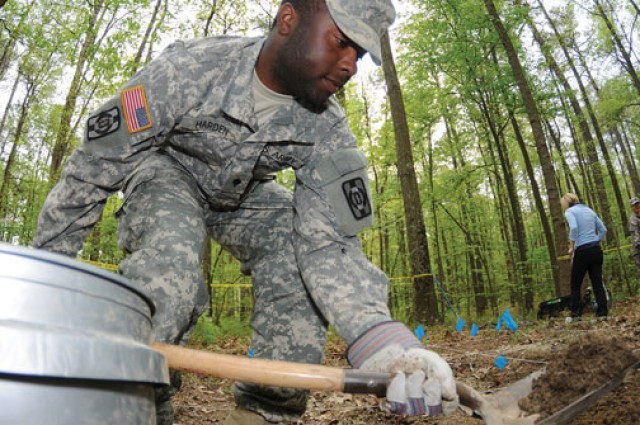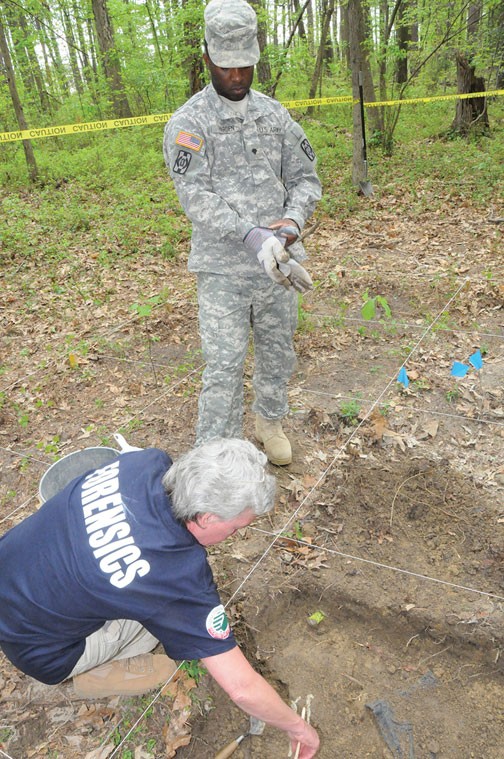THEY were barely visible to the personnel on site, but recognizable enough to warrant proceeding with meticulous caution.
"You'll have to dig around it gently," warned the man in charge. "You don't want to disturb anything else that could be buried beside it."
The crew of six had just discovered what resembled human skeletal remains, buried in a makeshift grave just off a dirt road in a wooded area.
"The abductor has said he buried the remains here," said Marine Staff Sgt. Brian Smith, the team's leader, "so we sent out a search and recovery team."
The skeletal remains are not real, and the search and recovery team isn't a crack forensic unit like the ones seen on TV's "CSI." They are mortuary affairs Soldiers and Marines acting as crime scene investigators and technicians in a unique training opportunity dubbed the Unidentified Human Remains Seminar.
"This seminar is designed to give participants the opportunity to learn how to locate clandestine graves, how to identify them, how to map it out and how to proceed in excavating it, all the while maintaining forensic evidence," said Dr. Lisa Leppo, a forensic anthropologist assigned to the Joint Mortuary Affairs Center at Fort Lee, Va.
The seminar, held at Fort Lee's Mortuary Affairs Training Area, lasted four days. It included about 30 Soldiers from the 49th Quartermaster Group's 111th and 54th Quartermaster companies located at Fort Lee, Reserve Soldiers from the 311th and 246th Quartermaster companies in Puerto Rico, and Marines from various locations.
The Virginia Institute of Forensic Science and Medicine in Richmond collaborated with the JMAC for the seminar, providing a number of nationally known experts to support the instruction.
Leppo, also JMAC's chief of training, said the first-of-its-kind training centered on crime scenes and buried remains, which mortuary affairs professionals aren't normally trained to handle.
"They get search and recovery exercises (in advanced individual training), which historically does not include locating clandestine graves," she said, noting that military mortuary affairs personnel normally work with remains found above ground.
"Military personnel typically go out when there's a major incident, like an airplane or helicopter crash. This is kind of preparing them to handle evidence in a medical-legal arena. The Armed Forces medical examiner has declared every battlefield casualty a forensic investigation-so we're trying to give them hands-on training to preserve evidence, understand what forensics is all about and how...it plays into an identification for the medical examiner."
Training participants were separated into four teams and provided various scenarios relating to the whereabouts of victims. They were responsible for locating the area, properly marking it, making observations, recording terrain features and other surroundings, and undertaking the painstaking process of excavating remains and gathering evidence.
The 54th's Spc. Earl Harden said the exercise was not only a refresher, it also opened up another side of mortuary affairs.
"We learned how to specify the area that we need to excavate, something that we were taught but never put into use," Harden said. "When we're downrange, we do the job that we train for and are familiar with. We don't practice this, so it's actually a privilege to come out here and put these skills to use."
Burial indicators relating to entomology and botany are skills mortuary affairs personnel couldn't hope to obtain in regular training, but they received a class on the subjects from Dr. Jason Byrd, a VIFSM-affiliated forensic entomologist. Byrd taught Soldiers how to make observations with respect to plant growth and insect inhabitation.
"We can use entomology to tell investigators how long an individual has been dead, and we can use botany to tell how long an individual has been in the grave site itself," Byrd said.
Participants also learned about medical evidence, odontology (the proper handling, examination and evaluation of dental evidence), creating biological profiles from anthropological evidence and canine search and recovery.
The skills servicemembers learned during the seminar will benefit them as they progress through the ranks-when they're more likely to be assigned to the Joint Prisoners of War/Missing in Action Accounting Command in Hawaii. The JPAC's mission is to recover the remains of missing Americans from past conflicts.
"Usually, when they become noncommissioned officers they get the option to volunteer for JPAC," said Staff Sgt. Matthew Biggs, a JMAC instructor. "They search for buried remains all over the world-Cambodia, Europe, China, even in North Korea-so the training will help."
In the meantime, the training the mortuary affairs Soldiers and Marines have received could be useful if civilian law enforcement should need assistance.
"Our hope is to get out to the law enforcement community that we have mortuary affairs personnel who are trained in this, and they could be able to assist (them)," she said. "They won't have jurisdiction, but they would be an invaluable asset to law enforcement who need a little help."






Social Sharing